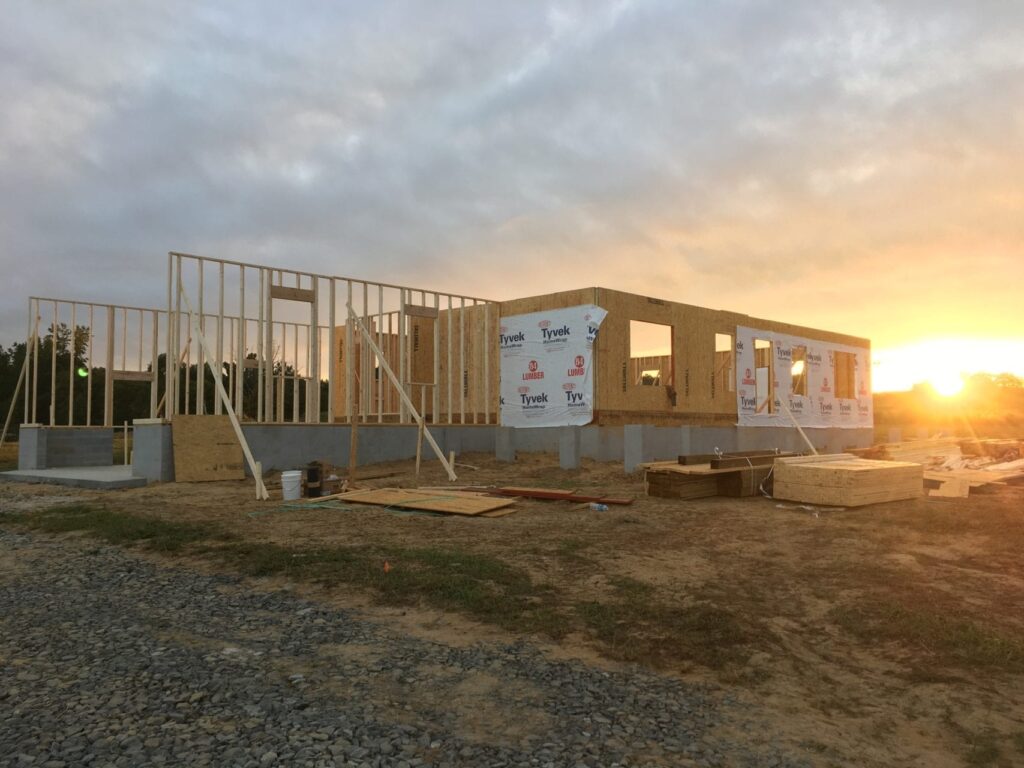

Walls can fall into two categories:
- Load Bearing: A load bearing wall bears a load from up above, usually another floor or roof load.
- Non-Load Bearing:A non-load bearing wall is built independent of the main load bearing structure of the home. It can be either an interior or an exterior wall, depending on the framing design utilized.
The single most common material used in house framing in the United States is wood; however, steel and concrete are being used regionally. In Southern areas there will be concrete walls partly because of the hurricanes and termites. But most homes still use wood for two main reasons:
- Wood’s availability.
- Wood’s Workability.

Wooden Frame Construction
The most common wall built is the wooden frame construction.
- The bottom plateis the first portion of framing that sits right on top of the floor system, which is the part that needs to be drilled for anchor bolts that attach the house to the concrete foundation.
- The studs are attached to the bottom They are specifically spaced and determined by your local building codes. Studs are the vertical walls — the “normal” walls of the house. Teakwood’s standard is 16” on center spacing of the studs. We use 2×4 as our standard as well, but often upgrade to 2×6
Note: If you have a wall and a long-planned surface, the wall could tend to move outward and to flex. The structural integrity is preserved by using two top plates that are attached together, thereby creating a rim. The top plates of intersecting walls are also tied in to provide greater rigidity. - Sheathing is applied to the exterior of the wall. The sheathing provides rigidity to the wall segment was well as a sub surface for the exterior finish of the home.
- The spaces where doors and windows sit are called rough openings. The rough openings have additional framing at the top to support the load. These supports are called headers, jacks and cripples. Headers are horizontal supports and jacks or cripples run vertically.
A header spans the top of a window, door, archway or walkway, and it preserves the structural integrity and distributes the weight across and to the sides of a framed rough opening. The header is usually two pieces of 2x lumber (with a plywood sandwiched between) for 2×4 walls the size of the header is determined by the load it is supporting from above.
And the jack or cripple studs are the studs that transfer the load to the foundation.Now that pieces of a wall have been explained, it’s time to put them all together. Most often walls are assembled on the ground, and then tilted up into

- place as one single unit. Finally they are anchored to the floor system.
- Once this process is completed throughout all the walls, the carpenters go through and straighten the walls and make sure they’re square and true.
-
- We here at Teakwood we always do 16” on center with a 2×4 or 2×6 studs.
- The Sheathing is always a continued structured panel using OSB plywood
- We Use and wrap the house with a water/wind barrier such as Tyvek http://www.dupont.com/products-and-services/construction-materials/building-envelope-systems/brands/water-barrier-systems/products/Thermawrap-r5.html
- We also overlap the second layer for added strength (leave out)
- We also let our Clients customize the walls as they see fit
Some of our clients have written scriptures on the wall
Past clients have created time capsules to leave in the wall cavity.
-
- We can also future proof the build with features such As:
- Aging owner/Resident
- Extra fortification for cabinets
- Planning a door for a future addition, but install a window now.
- We can also future proof the build with features such As:
